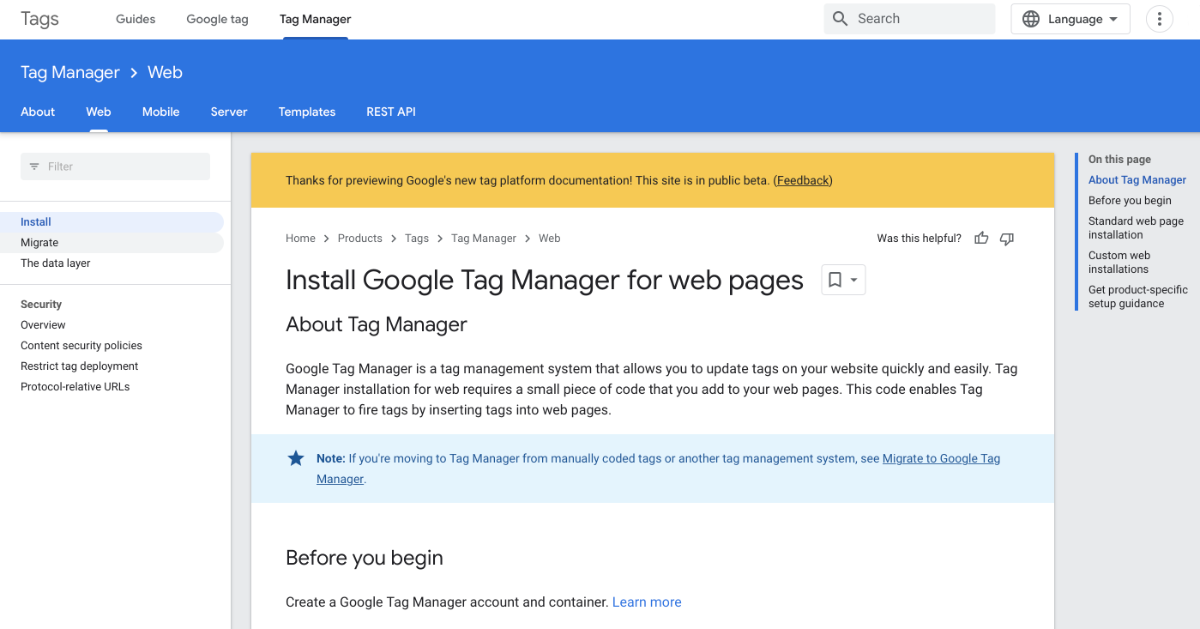One of the most sought after web marketing and analytics tools is Google Tag Manager. In the article we will describe the principle of operation, features, advantages and disadvantages of this service. You will also learn about the key terms of GTM, and who will benefit from it.
What is Google Tag Manager used for
This is a free service from Google that helps you manage tags in your website and app code. Tags are special elements of HTML or JavaScript code designed to connect external programs, services or other tools. Proper implementation of tags provides marketers, analysts and webmasters with ample opportunities for data collection and a number of other operations.
Google Tag Manager was launched in 2012 and immediately gained a lot of popularity, as it greatly simplified the life of site owners and online advertising professionals. Previously, they had to enter all tags (analytics, remarketing, testing, banners, etc.) manually. This took a lot of time and caused certain inconveniences – for example, there was always a risk of "breaking" the site due to an error in the code. In addition, adding or modifying tags required at least basic knowledge of HTML or JavaScript.
- Automate the work with leads from the Facebook advertising account
- Empower with integrations and instant transfer of leads
- Don't spend money on developers or integrators
- Save time by automating routine tasks
The advent of Google Tag Manager radically changed the situation: since then, marketers and webmasters manually enter only the GTM code. After that, they can perform all operations with tags (adding, updating, debugging, deleting) through the service interface – conveniently, quickly and safely.

Advantage of Google Tag Manager
Tag Manager from Google is very popular due to a number of useful advantages. These include:
- Wide opportunities for connecting key analytical services: Google Analytics, AppsFlyer, as well as tags for collecting data from social networks: Facebook, Twitter, LinkenIn, Pinterest, etc.
- With it, you can implement various types of testing and feedback (Google Polls, Google Optimize), set remarketing tags (Google Ads, Facebook, DoubleClick), place advertising banners, add call tracking, etc. A complete list of supported functions and platforms is published in the service help, all these integrations are easily implemented through its interface.
- GTM helps to optimize the performance of the site / application: its tags take less code than manually added ones, so pages with them load faster.
- The manager has a debug mode that allows you to pre-check the health and effectiveness of tags before placing them in the site or application code.
- The program saves all changes made to the code, which makes it possible to easily and quickly "roll back" to any previous version (versioning support). In addition, the version control system allows you to keep track of which users made which changes.
- GTM has a flexible setting of access levels for different users. For example, the site owner may grant the marketer access not to all, but only to certain functions, etc.
- This is a completely free tool that helps you quickly and easily control tags without the need to contact specialists or learn HTML / JavaScript.
Disadvantage of Google Tag Manager
As for the disadvantages of Google Tag Manager, they are also present:
- You will need basic knowledge of HTML and JavaScript to embed GTM code into your website/app, as well as to add custom custom tags.
- The performance of all tags configured with it directly depends on the GTN container code – if it is damaged, they will stop working. That is, sometimes the system crashes after making changes to the structure or properties of pages.
- The service does not have online support and reporting options.

Why use Google Tag Manager
Who and what is Google Tag Manager useful for:
- Marketers and analysts: with it, they can easily track KPIs for websites and applications, implement end-to-end analytics, and connect external services to collect marketing data.
- SEO and PPC professionals: with it, they will be able to effectively set goals, evaluate the results of their campaigns, and implement remarketing.
- Website owners: with it you can set up and manage web analytics without having deep knowledge of HTML / JavaScript and without contacting specialists.
- Advertising and marketing agencies: with it, they will be able to efficiently and quickly maintain a large number of accounts of their clients.
Conclusion. What is a Google Tag Manager
Google Tag Manager is a multifunctional free tool that greatly simplifies and speeds up the setup of user analytics for websites and mobile applications. A real must have for marketers, analysts and web project owners.
What do you do with the data you get from Facebook lead forms? Do you send them to the manager, add them to mailing services, transfer them to the CRM system, use them to implement feedback? Automate all of these processes with the SaveMyLeads online connector. Create integrations so that new Facebook leads are automatically transferred to instant messengers, mailing services, task managers and other tools. Save yourself and your company's employees from routine work.

